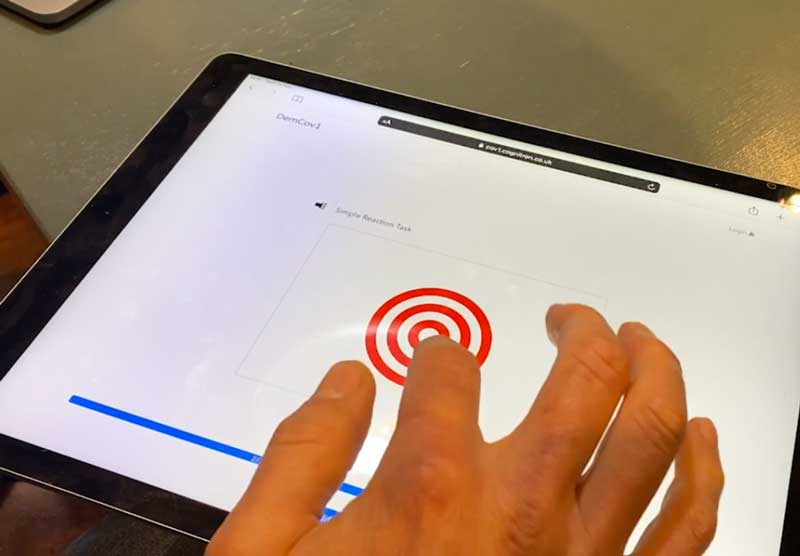
Minder Tests
Collaborators:
Prof David Sharp, Professor of Neurology, Centre director
Dr Adam Hampshire, Senior Lecturer
Dr Amy Jolly, Postdoctoral Researcher
Will Trender, Research Postgraduate
Pip Batey, Designer
Lauren Dowling, Designer
and Minder Champions / research participants.
What are Minder Tests?
Minder Tests are a series of online cognitive assessments developed by clinicians and researchers from across Imperial College London and the UK DRI CRT. The tests seek to assess ‘thinking’ abilities such as memory, language, reasoning and perception.
To complete the tests, a clinician must first set up the assessment and send a link to the intended participant via email. By accessing the link, the participant can complete the full assessment with the final results being sent back to the clinician for review. Taking cognitive tests away from the clinic and into the home environment has many advantages for longitudinal dementia research

What were the aims and objectives of the project?
To enable the assessment procedures to be carried out remotely, an initial online testing platform was developed by the clinical team. Gathering test data through research studies with people living with dementia has contributed to a greater understanding of what the test results mean in this context. Hopes to scale up the platform for use across memory clinics nationwide meant that certain aspects of user experience required reconsideration. Designers from Helix were onboarded to improve the user-interface design to ensure high-levels of usability and to enhance the overall user experience. A user-centred approach would ensure that all stakeholder needs were factored into the final designs for the platform.
Project stage

How was the project approached?
Cross disciplinary collaboration was necessary to translate user needs into design requirements for both clinician and patient-facing prototypes. Being integrated into the weekly team meetings afforded direct access to the clinicians and researchers which allowed the designers to scope the breadth of the project, understand the clinical needs and gather insights around the issues being encountered with the existing platform.
Three key opportunity areas were identified:
- Enhance the user experience – Break down the overall user flow and identify how to simplify the experience for both clinicians and patients.
- Improve visual design – Using visual design to improve the interface to be accessible and inline with DRI/Minder brand guidelines.
- Integrate testing into the design process – Create low fidelity prototypes to test and iterate the design of the service with clinicians and patients.
To begin with, low-fidelity click-through prototypes were developed to explore potential improvements. Throughout the project, weekly presentations and demonstrations were delivered to the clinical team to showcase progress. All updates were critiqued with potential changes discussed and subsequently implemented by the next meeting. This feedback loop enabled the Helix team to clarify and respond to the evolving design requirements.
What role did Patient and Public Involvement and Engagement (PPIE) play in this project?
To ensure the needs of patients were equally considered, workshops were hosted with Minder Champions to discuss the difficulties encountered with the platform and assessment procedure. Accessibility was a key theme to emerge but more challenging still was the lengthy assessment duration. For instance, patients who struggled with the initial simpler tasks still had to attempt tasks of increasing difficulty to complete the entire 40-minute assessment. Having presented these user insights to the clinical team, feedback about a potentially overwhelming process was acknowledged. This prompted a clinical decision to develop a new ‘battery’ of tests, where participants who struggled initially could be fast-tracked through the process, thus skipping more challenging tasks. Such an approach would provide the clinician with the relevant data whilst avoiding a patient’s disappointment when unable to complete certain cognitive tasks. The result was that the product and service retained its core function whilst providing a built-in safety net to accommodate all outcomes.
Taking into account the insights gathered, the patient-facing prototype was further developed before being presented in later workshops with the Minder Champions. This enabled particular features to be critiqued and suggestions made to ensure appropriate usability.

What were the key insights to emerge?
It is important to carefully consider the impact of introducing technology into the lives of people with dementia and their carers. Communicating the role of the particular technology and offering clear guidance on how to use it is paramount to ensure that it is used effectively and does not become a source of frustration. Participants must be aware of the capabilities of the technology and the current stage of development. Many of the Minder Champions were unsure about the purpose of the testing procedure and what the test results would mean for future care interventions. Setting clear expectations about a participant’s role will prevent confusion about the purpose of the research and what the outcomes will mean for them. Devising a suitable onboarding strategy may help to address any uncertainties at an early stage.
It is important to consider where technologies may ‘go wrong’ or result in an undesired outcome and where safeguarding can come into play. Feelings of stress, burnout and frustration are common, particularly amongst those caring for people living with dementia. Therefore we must be conscious of not unintentionally overloading them. Technologies must be carefully evaluated and scrutinised before being introduced in the homes of people with dementia. Carrying out preliminary tests with participants outside of the dementia cohort may help to identify potential issues that can be examined and rectified before the study begins. In the case of Minder Tests, this was the first task of the design team, to use the platform themselves, noting all observations. This is a quick and easy way of troubleshooting various technologies.

Illustrations are often used to enhance the visual appeal of an interface. When designing for dementia, visual assets should be used to add clarity to written information provided or act as stand-alone methods of communication. Therefore it is important to evaluate the associated visual perception of an image or illustration to reduce the likelihood of it being misinterpreted or causing confusion. Many free graphics that are available for download online feature abstract shapes and do not typically follow realistic proportions. At first, such illustrations featuring abstract shapes were added to the patient-facing prototypes of Minder Tests in order to bring the platform to life. Once critically assessed, all abstract shapes were removed and designs were simplified to ensure realistic proportions were used in order to prevent any confusion or misinterpretation.

What were the final project outcomes?
The deliverables for Minder Tests including final designs for both the patient and clinician-facing prototypes. Incorporated into these new designs was an enhanced and improved overall user experience that sought to promote clear navigation and safeguarding.
